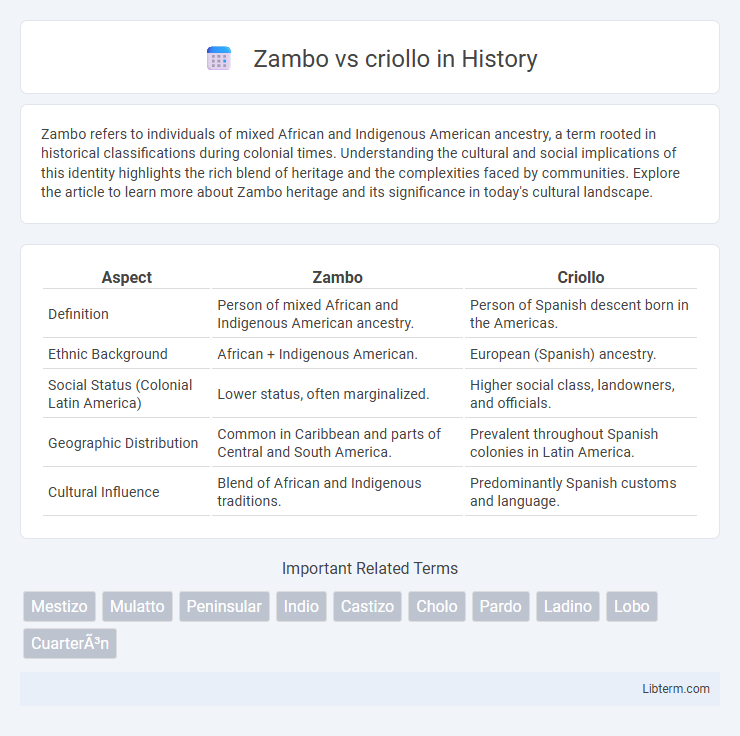Zambo refers to individuals of mixed African and Indigenous American ancestry, a term rooted in historical classifications during colonial times. Understanding the cultural and social implications of this identity highlights the rich blend of heritage and the complexities faced by communities. Explore the article to learn more about Zambo heritage and its significance in today's cultural landscape.
Table of Comparison
| Aspect | Zambo | Criollo |
|---|---|---|
| Definition | Person of mixed African and Indigenous American ancestry. | Person of Spanish descent born in the Americas. |
| Ethnic Background | African + Indigenous American. | European (Spanish) ancestry. |
| Social Status (Colonial Latin America) | Lower status, often marginalized. | Higher social class, landowners, and officials. |
| Geographic Distribution | Common in Caribbean and parts of Central and South America. | Prevalent throughout Spanish colonies in Latin America. |
| Cultural Influence | Blend of African and Indigenous traditions. | Predominantly Spanish customs and language. |
Understanding Zambo and Criollo: Definitions
Zambo refers to individuals of mixed African and Indigenous American ancestry, a term historically used in Latin America to describe this specific ethnic blend. Criollo denotes people of pure Spanish descent born in the Americas, emphasizing colonial heritage and social status. Understanding these definitions highlights distinct cultural and racial identities pivotal in the socio-historical context of Latin American society.
Historical Origins of Zambo and Criollo Identities
Zambo identity historically emerges from the intermingling of African and Indigenous peoples during the colonial period in Latin America, reflecting complex social hierarchies established by European colonizers. Criollo identity originated from Spanish settlers born in the Americas, embodying a distinct cultural and social status that differentiated them from Peninsulares and Indigenous populations. These identities played crucial roles in shaping social dynamics, racial classifications, and cultural expressions in colonial and post-colonial Latin America.
Genetic Background: Zambo vs Criollo
Zambo populations exhibit a genetic background characterized by a mix of African and Indigenous American ancestry, reflecting historical admixture events during colonial periods. Criollo populations generally possess predominantly European ancestry, with varying degrees of Indigenous American and African genetic contributions depending on the region. Genetic studies reveal distinct allele frequencies and markers that differentiate Zambo from Criollo groups, highlighting their unique ancestral heritage and population history.
Social Roles in Colonial Societies
Zambo and Criollo social roles in colonial societies reflected complex racial hierarchies where Zambos, of mixed Indigenous and African descent, were often relegated to lower-status labor and marginalized positions. Criollos, people of pure Spanish descent born in the Americas, occupied elite roles including landowners, merchants, and government officials, reinforcing colonial power structures. These distinctions entrenched racial and social inequalities, affecting access to wealth, political influence, and social mobility.
Regional Distribution and Population Centers
Zambo populations are predominantly found in parts of Latin America such as Colombia, Ecuador, and Brazil, often in coastal and riverine regions where Afro-Indigenous communities have historically settled. Criollo groups are primarily concentrated in the Caribbean islands, Venezuela, and parts of Central and South America, particularly in urban centers like Caracas, Havana, and San Juan, reflecting their mixed European, African, and Indigenous heritage. Population centers such as Cartagena and Guayaquil feature significant Zambo communities, whereas cities like Santo Domingo and Caracas highlight Criollo cultural presence and demographic concentration.
Cultural Influence and Traditions
Zambo and Criollo identities profoundly shape cultural traditions in Latin America, with Zambo heritage highlighting Afro-Indigenous fusion evident in music, dance, and spiritual practices such as candomble and maroon communities. Criollo culture reflects Spanish colonial legacies, emphasizing Catholic rituals, language, and mestizo customs in festivals like Dia de los Muertos and regional gastronomy. Both identities intertwine in cultural expressions, reinforcing diverse social narratives and preserving ancestral knowledge across generations.
Representation in Art and Literature
Zambo and criollo identities are distinct themes frequently explored in Latin American art and literature to highlight complex racial and cultural histories. Zambo representations often emphasize Afro-Indigenous heritage, illustrating resilience and hybrid cultural identity, while criollo depictions typically focus on European-descended elites and colonial power dynamics. These portrayals reveal societal structures and tensions, using symbolism and narrative to explore themes of race, identity, and social hierarchy.
Legal Status and Social Hierarchies
Zambo and Criollo classifications historically influenced legal status and social hierarchies in colonial Latin America, where Criollos--Spaniards born in the Americas--held higher legal privileges and access to political offices compared to Zambos, individuals of mixed Indigenous and African descent. Colonial laws and caste systems systematically marginalized Zambos, restricting their rights and reinforcing social stratification by limiting property ownership, educational opportunities, and legal recourse. Despite these structural inequalities, Criollos capitalized on their European lineage to dominate local governance and economic power, perpetuating racialized social hierarchies that advantaged them over Zambos.
Contemporary Perceptions and Challenges
Contemporary perceptions of Zambo and Criollo identities reflect complex socio-cultural dynamics influenced by historical legacies and ongoing struggles for recognition. Zambo individuals, often facing marginalization due to their mixed African and Indigenous heritage, encounter challenges in social inclusion and access to resources compared to Criollos, who are typically associated with Spanish colonial ancestry and higher socio-economic status. These disparities underscore persistent issues in racial and cultural identity politics, affecting integration and equality in modern societies.
Comparative Legacy: Zambo and Criollo Today
Zambo and Criollo identities persist in contemporary society, reflecting complex historical legacies shaped by colonial racial classifications. Zambo heritage embodies Afro-Indigenous connections often marginalized yet increasingly recognized in cultural revitalization and social justice movements. Criollo identity, rooted in Spanish descent and colonial elite status, continues to influence societal hierarchies and regional cultural traditions across Latin America.
Zambo Infographic

 libterm.com
libterm.com